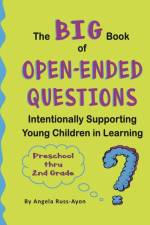av Angela Ayon
179,-
Fotografías coloridas de frutas deliciosas hacen de esta una experiencia exploratoria. Los niños pequeños pueden aprender a identificar frutas y familiarizarse con la terminología y conceptos básicos de STEM, y luego ampliar o interpretar los términos de diferentes maneras. Este libro está escrito con un texto mínimo y ofrece oportunidades para la observación, el descubrimiento científico, la experimentación y otros momentos de enseñanza en el jardín y la cocina. Es una gran adición a cualquier tema de frutas, jardinería, cosecha, nutrición, grupo de alimentos o ciencias de la vida para padres de niños pequeños o educadores de niños preescolares y de primera infancia. Esta es una manera eficaz de hacer que los niños se entusiasmen con la alimentación saludable a medida que identifican, aprenden y diferencian entre una variedad de frutas deliciosas y sus características. En este libro ilustrado con 36 páginas se incluyen datos sobre frutas, un guía para el lector y sugerencias para una investigación abierta. Colorful photographs help young children identify a variety of fruit while being introduced to basic science and math concepts. There is a different option to consider and discuss on each page. By comparing and contrasting what they observe, children can better understand the characteristics, similarities, differences, and relationships between things, and develop analytical, problem-solving, and critical thinking skills. In addition, they can enhance their language skills by describing what they observe. I Spy Fruit is a great addition to any fruit, gardening, harvest, nutrition, food group, or life science theme for parents of young children or preschool and early childhood educators.Included in this picture book are a reader's guide and suggestions for open-ended inquiry.34 pages | Size: 8.5" H x 8.5" W | Available in English and SpanishFind creative ways to connect this concept book to a theme, activity, or experiment. Freeze fruit, conduct a sink and float experiment, taste test fresh vs. dried fruit, make juice, observe fruit as it decays, manipulate a simple machine, such as a peeler or shredder, and so forth.Foundation/Domain: Life Science, Physical Science, and Early MathBenefits:· Exposure to a variety of fruits.· Compare and contrast sizes, shapes, colors, and textures· Explore positions in space: over, under, beside, etc.· Recognize and count parts and pieces· Explore opposites: high/low, top/bottom, same/different, etc.· Introduce scientific and mathematical terms: patterns, freeze vs. thaw, sink vs. float, fresh vs. rotting, real vs. pretend· Encourage conversation and the use of descriptive words· General introduction to the sciences and early math¿This book is printed on demand. Please flip through at least one of the books you receive and contact the publisher directly as soon as possible if you have any quality concerns.Bulk Orders: This title is available in bulk directly from the publisher for early childhood and nutrition programs, conferences, non-profit initiatives, licensing, or grants that promote healthy eating, fruits, gardening, farm-to-table, anti-obesity, and STEM initiatives. Contact the publisher directly for quotes, orders, and discounted pricing.




